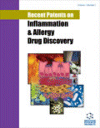- Home
- A-Z Publications
- Recent Patents on Inflammation & Allergy Drug Discovery
- Previous Issues
- Volume 12, Issue 1, 2018
Recent Patents on Inflammation & Allergy Drug Discovery - Volume 12, Issue 1, 2018
Volume 12, Issue 1, 2018
-
-
Diabetic Complications and Insight into Antidiabetic Potentialities of Ethno-Medicinal Plants: A Review
More LessAuthors: Muhammad Bilal, Muhammad S. Iqbal, Syed B. Shah, Tahir Rasheed and Hafiz M.N. IqbalBackground: The naturally inspired treatment options for several disease conditions and human-health related disorders such as diabetes mellitus have gained considerable research interest. In this context, naturally occurring plants and herbs with medicinal functionalities have gained special place than ever before in the current medicinal world. Objective: The objective of this review is to extend the current knowledge in the c Read More
-
-
-
The Promising Pharmacological Effects and Therapeutic/Medicinal Applications of Punica Granatum L. (Pomegranate) as a Functional Food in Humans and Animals
More LessBackground: Punica granatum L. (pomegranate), is a shrub mostly available in the Mediterranean Sea region. The fruits have gained the substantial attention among researchers due to their promising biological activities including anti-inflammatory, antibacterial, antidiarrheal, immune modulatory, antitumor, wound healing and antifungal that have been attributed to various constituents of seeds, bark, juice, pericarp, a Read More
-
-
-
Anti-Inflammatory Drugs and Herbs with Special Emphasis on Herbal Medicines for Countering Inflammatory Diseases and Disorders - A Review
More LessBackground: Diseases with inflammatory etiopathology have increased in incidence in recent times. Drugs used for therapeutic management of such inflammatory diseases are relieving the ailment but at the same time also countering serious life threatening consequences. Moreover, they are costly and rarely available at all places. In this context, research and development on medicinal herbs have opened a new era in the Read More
-
-
-
In vitro And In vivo Immunomodulating Properties of Mesenchymal Stem Cells
More LessAuthors: Divya Chaudhary, Raj N. Trivedi, Ashima Kathuria, Tapas K. Goswami, Rekha Khandia and Ashok MunjalBackground: Mesenchymal Stem Cells (MSCs) are self-renewing, multipotent progenitor cells with multilineage potential to differentiate into all cell types of mesodermal origin, such as adipocytes, osteocytes and chondrocytes. Mesenchymal Stem Cells (MSCs) are adult stem cells which can be isolated from human and animal sources. Objective: Besides the differentiation potential of MSCs, these also regulate the immune respo Read More
-
-
-
Role of Curcumin in Regulation of TNF-α Mediated Brain Inflammatory Responses
More LessAuthors: Tirthraj Baj and Rohit SethBackground: Inflammation is a protective response of the body system that protects the body from the various kinds of external and internal insults; however, it has been found that most chronic illnesses are caused by dysregulated and excessive inflammation. Inflammation plays a major role in developing neurological diseases. In the brain cytokines, TNF-α and TNF-β are known to mediate inflammation in many diseases. Read More
-
-
-
Complications of Diabetes: An Insight into Genetic Polymorphism and Role of Insulin
More LessBackground: Diabetes Mellitus (DM) is an advanced and chronic endocrine disorder characterized by an insufficiency of insulin secretion from pancreatic β-cells and liver, adipose tissues, and skeletal muscles. Objective: The main objective of this study is to understand the mechanism and genes which are responsible for the prevalence of diabetes. The study also covers various types of diabetic complications with special re Read More
-
-
-
Effect of Prolonged Anti-HM1: IMSS Entamoeba histolytica Antibody Activity in Humoral and Cellular Immunity of Experimentally Induced Animal Model
More LessAuthors: Swati Bagde and Vinod SinghBackground: The Cellular immunity plays an important role in amoebic infections, whereas humoral immune responses have little influence on the outcome of the disease. Chronic infestation with Entameoba histolytica, a common protozoan parasite, has been associated with autoimmune phenomena, including the appearance of antibodies to colonic epithelial cells. The mechanism whereby the protozoan parasite E. histoly Read More
-
Most Read This Month
Article
content/journals/iad
Journal
10
5
false
en


